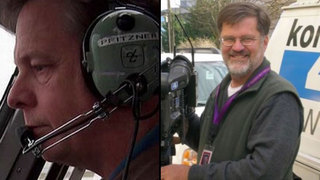SEATTLE -- The National Transportation Safety Board has issued its conclusions in the crash of a helicopter from the roof of the KOMO-TV building in Seattle more than two and a half years ago.
The crash on March 18, 2014 resulted in the death of pilot Gary Pfitzner and photographer Bill Strothman. It also injured several people sitting in traffic on the ground.
To understand what happened, think of the power steering on your car. If the power steering stops working, as when you run out of gas, it can be much harder to turn the wheel.
The NTSB says the probable cause of the crash is, "The loss of control due to a loss of hydraulic boost to the tail rotor pedal controls at takeoff, followed by a loss of hydraulic boost in the main rotor controls after takeoff."
Yet because of the fire, and the lack of any sort of on board flight recorder such as a black box, or on board camera, investigators don't know why.
"The reason for the loss of hydraulic boost to the main and tail rotor controls could not be determined," according to NTSB.
Security camera video from multiple locations such as the Seattle Center provided visual evidence of the helicopter lifting off the roof of the helipad, and immediately yawing, or rotating to the left, and going into a spin. "As it continues to rotate...the helicopter deviated from a level attitude, pitching nose down and banking right, consistent with a loss of main rotor control." according to the report.
The helicopter hit Broad Street, resulting in a large fire.

The investigation was a particularly technical one, which is why it took two-and-a-half years to complete. It involved testing in France – where the helicopter was designed, initially occurring in simulators and then running multiple scenarios in an identical aircraft.
The company that built it was known as American Eurocopter (now Airbus Helicopters). It was a model AS 350 B2. It was owned by Helicopters Inc., based in Cahokia, Ill. Helicopters Inc. provides services to TV stations across the country, including KING TV.
The crash scenario is similar to a fatal accident last year in Frisco, Colo. that killed the pilot of an air medical helicopter and injured two others, according to Texas aviation attorney Michael Slack of the firm Slack & Davis. He is representing the family of photographer Bill Strothman in a suit against Airbus Helicopter. He is also involved in the Colorado accident.
"He thinks everything's fine," Slack said of the pilots."He starts to pull pitch to take off and the next thing he knows he has a gyroscopic effect. He does not have enough rudder authority, pedal authority to stop the yaw tendency like you ordinarily would. It's a surprising thing for pilots who have survived it, and it typically leaves them in a very vulnerable situation, obviously."
A spokesman for Airbus Helicopters says the company declined comment, because of the pending litigation.
Airbus Helicopters produced for the American market are now equipped with a "black box" or camera system, known as the Appareo Vision 1000. Installations began in 2011, long after the accident aircraft was built.


